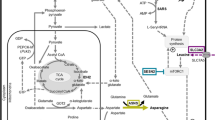Abstract
EVIDENCE that viruses and chemical carcinogens alter the ongoing synthetic programme of cells has been presented1,2. Chondroblasts and melanoblasts transformed with a temperature-sensitive Rous sarcoma virus cease synthesising the chondroblast-unique sulphated proteoglycan and melanin, respectively3. Shifted to non-permissive temperature, these cells re-initiate the synthesis of the chondroblast-unique sulphated proteoglycan and melanin. Similar results have been obtained using chick myogenic cells4,5. Normal presumptive myoblasts undergo a limited number of replications, yielding postmitotic, mononucleated myoblasts. Postmitotic myoblasts initiate the synthesis of muscle-specific myosin heavy and light chains and fuse into myotubes6,7. In contrast, ts-viral transformed myogenic cells continue to replicate, do not initiate the synthesis of muscle-specific myosins and do not fuse. 24–48 h after shifting to non-permissive temperature, many transformed myogenic cells withdraw irreversibly from the cell cycle, initiate the synthesis of muscle-specific (unpublished data) myosins and fuse. Apparently when the transformation factor is expressed the cells do not withdraw from the cell cycle, and as a consequence of being forced to cycle, do not terminally differentiate. To probe the mechanisms that might be common to the generation of terminally differentiated cells from normal precursor cells, and to the generation of malignant cells from normal precursor cells, we studied the effects of phorbol-12-myristate-13-acetate (PMA) on myogenesis. Of the purified phorbol esters, PMA is the most potent as a tumour-promoting agent and as a mitogen8–12. We report here that PMA mimics some of the effects of the Rous sarcoma tumour agent on myogenesis.
This is a preview of subscription content, access via your institution
Access options
Subscribe to this journal
Receive 51 print issues and online access
$199.00 per year
only $3.90 per issue
Buy this article
- Purchase on Springer Link
- Instant access to full article PDF
Prices may be subject to local taxes which are calculated during checkout
Similar content being viewed by others
References
Tooze, J. The Molecular Biology of Tumour Viruses (Cold Spring Harbor Press, 1973).
Berenblum, I. in Frontier of Biology: Carcinogenesis as a Biological Problem (eds Neuberger, A. & Tatum, E.) 67–73 (North-Holland, Amsterdam, 1974).
Roby, K., Boettiger, D., Pacifici, M. & Holtzer, H. Am. J. Anat. 147, 401–405 (1976).
Fiszman, M. & Fuchs, P. Nature 254, 429–431 (1976).
Holtzer, H., Biehl, J., Yeoh, G., Meganathan, R. & Kaji, A. Proc. natn. Acad. Sci. U.S.A. 72, 4051–4055 (1976).
Holtzer, H., Strahs, K., Biehl, J., Somlyo, A. & Ishikawa, H. Science 188, 943–945 (1975).
Chi, J., Fellini, S. & Holtzer, H. Proc. natn. Acad. Sci. U.S.A. 72, 4999–5003 (1976).
Hecker, E. Cancer Res. 28, 2338–2349 (1968).
Sivak, A. & van Duuren, D. Science 157, 1443–1444 (1967).
Diamond, L., O'Brien, S., Donaldson, C. & Shimizu, Y. Int. J. Cancer. 13, 721–730 (1974).
Wegler, M. & Weinstein, B. Nature 259, 232–233 (1976).
O'Brien, T., Sisiman, R. & Boutwell, R. Cancer Res. 2426–2433 (1975).
Bischoff, R. & Holtzer, H. J. Cell Biol. 41, 188–197 (1969).
Adelstein, R., Conti, M., Johnson, G., Pastan, I. & Pollard, T. Proc. natn. Acad. Sci. U.S.A. 69, 3693–3697 (1972).
Chi, J., Rubinstein, N. & Holtzer, H. J. Cell Biol. 67, 523–537 (1975).
Holtzer, H., Croop, J., Dienstman, S., Ishikawa, H. & Somylo, A. Proc. natn. Acad. Sci. U.S.A. 72, 513–517 (1976).
Paterson, B. & Strohman, R. Devl Biol. 29, 113–136 (1972).
Dienstman, S. & Holtzer, H. in Cell Cycle and Cell Differentiation (eds Reinert, J. & Holtzer, H.) 1–18 (Springer-Verlag, Heidelberg, 1975).
Holtzer, H. & Sanger, J. in Research in Muscle Development and in the Muscle Spindle (eds Banker, B., Pryzblski, X. & Victor, M.) 22–36 (Excerpta Medica, Amsterdam, 1972).
Holtzer, H. et al. Q. Rev. Biophys. 8, 523–557 (1975).
Nameroff, M. & Munar, E. Devl Biol. 49, 288–293 (1976).
Holtzer, H., Abbott, J. & Lash, J. Anat. Rec. 131, 567 (1958).
Okazaki, K. & Holtzer, H. J. Histochem. Cytochem. 13, 726–738 (1965).
Burton, K. Biochemistry 62, 315–323 (1956).
Fellini, S. & Holtzer, H. Differentiation 6, 71–74 (1976).
Offer, G. in Cold Spring Harb. Symp. quant. Biol. 37, 87–93 (1973).
Author information
Authors and Affiliations
Rights and permissions
About this article
Cite this article
COHEN, R., PACIFICI, M., RUBINSTEIN, N. et al. Effect of a tumour promoter on myogenesis. Nature 266, 538–540 (1977). https://doi.org/10.1038/266538a0
Received:
Accepted:
Issue Date:
DOI: https://doi.org/10.1038/266538a0
This article is cited by
-
Expression of proto-oncogenes and muscle specific genes during cardiac hypertrophy and development in rats and humans
Journal of Biosciences (1994)
-
12-O-tetradecanoylphorbol-13-acetata (TPA) directly inhibits spontaneous immunoglobulin secretion byin vivo antigen-induced human lymphoblastoid B cells
Journal of Clinical Immunology (1984)
-
Transformation of avian myogenic cultures with myelocytomatosis virus strain 29
Wilhelm Roux's Archives of Developmental Biology (1984)
-
Induction of myosin light chain synthesis in heterokaryons between normal diploid cells
In Vitro (1982)
Comments
By submitting a comment you agree to abide by our Terms and Community Guidelines. If you find something abusive or that does not comply with our terms or guidelines please flag it as inappropriate.



